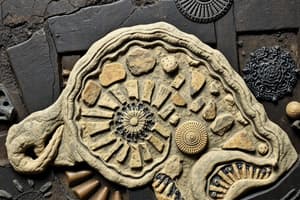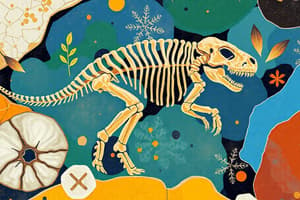Podcast
Questions and Answers
What is a true form fossil?
What is a true form fossil?
- Shells, teeth, or bones of an organism (correct)
- An impression left by an organism
- An animal's footprints preserved in sediment
- Mineral rock that has filled a mould
Which of the following conditions is NOT necessary for fossilisation to occur?
Which of the following conditions is NOT necessary for fossilisation to occur?
- Low temperatures
- Absence of decomposers
- Burial by sediment
- Presence of O2 and H2O (correct)
How does the fossil record provide evidence for evolution?
How does the fossil record provide evidence for evolution?
- It shows that organisms do not change over time.
- It demonstrates that fossilisation is very common.
- It indicates that all organisms lived simultaneously.
- It illustrates that more complex organisms emerged over time. (correct)
Which step is NOT involved in the formation of cast fossils?
Which step is NOT involved in the formation of cast fossils?
What is the significance of missing links in the fossil record?
What is the significance of missing links in the fossil record?
Which type of fossil would be classified as a trace fossil?
Which type of fossil would be classified as a trace fossil?
What does the increasing variety of fossils in upper rock layers suggest?
What does the increasing variety of fossils in upper rock layers suggest?
What is the first step in the fossilisation process?
What is the first step in the fossilisation process?
What is the primary mechanism through which natural selection operates in populations?
What is the primary mechanism through which natural selection operates in populations?
Which of the following is a characteristic of genetic drift?
Which of the following is a characteristic of genetic drift?
In which type of speciation do new species arise without geographic separation?
In which type of speciation do new species arise without geographic separation?
Which piece of evidence for evolution shows similarities in essential body structures across different species?
Which piece of evidence for evolution shows similarities in essential body structures across different species?
What concept combines Darwinian evolution with genetic principles?
What concept combines Darwinian evolution with genetic principles?
Which process contributes directly to introducing new traits in a population?
Which process contributes directly to introducing new traits in a population?
What role does biogeography play in understanding evolution?
What role does biogeography play in understanding evolution?
Which of the following best explains the findings of molecular biology in evolutionary contexts?
Which of the following best explains the findings of molecular biology in evolutionary contexts?
Flashcards are hidden until you start studying
Study Notes
What are Fossils?
- Preserved remains and traces of organisms over 10 000 years old.
- Found in rock.
Types of Fossils
- Trace fossils: Footprints, trails, burrows, and coprolites (fossilized dung)
- Moulds: Impressions left by an organism.
- Casts: Formed when a mould is filled with mineral rock (mineralisation).
- Trueform fossils: Shells, teeth, and bones.
How do Cast Fossils Form?
- Fossils form under very specific conditions.
- An animal dies and its skeleton is buried quickly by sediment.
- The sediment hardens, turning to stone.
- Groundwater dissolves the skeleton, leaving a mould.
- Minerals from the groundwater crystallise inside the mould, forming a cast.
- Erosion exposes the fossil on the Earth's surface.
Conditions for Fossilisation
- Absence of decomposers
- Absence of oxygen and water
- Low temperatures
Fossil Evidence for Evolution
- The fossil record provides strong evidence for evolution.
- Imagine a puzzle with 9/10 pieces missing; becoming a fossil is highly unlikely.
- Many factors can prevent an organism from being fossilized, or a fossil from being found.
- Shows changes in structure over time.
- Organisms in the fossil record have become more complex over time.
- For example, the progression from unicellular organisms to invertebrates to vertebrates.
- More recent (younger) fossils resemble organisms living today.
- The variety of fossils increases in the upper, more recent layers of rock.
- No fossil record exists of any modern living plants or animals.
- Have they avoided being fossilised or evolved?
- This suggests that organisms found as fossils either became extinct or evolved into species currently living.
- Missing links – the common ancestors provide strong evidence for evolution
- For example, Archaeopteryx is considered a transitional fossil between dinosaurs and birds.
Evolutionary Biology
- The study of how life on Earth has changed over time
- Emphasizes processes like natural selection, mutation, and genetic drift
Natural Selection
- The driving force behind adaptation in organisms
- Individuals with advantageous traits are more likely to survive and reproduce
- Over time, these traits become more common in the population
Mutation
- Changes in DNA sequences that introduce new traits
- The source of genetic variation within a population
- Mutations can be beneficial, harmful, or have no effect
Genetic Drift
- Random changes in allele frequencies within a population
- More significant in smaller populations
- Can result in the loss of genetic diversity
Speciation
- The process by which new species arise
- Allopatric speciation: occurs when populations are geographically isolated
- Sympatric speciation: occurs within the same geographic area, often due to polyploidy or habitat differentiation
Evidence for Evolution
- Fossil Record: Shows changes in species over time, including transitional forms
- Comparative Anatomy: Homologous structures (similar structures, different functions) indicate common ancestry; Analogous structures (similar functions, different structures) indicate convergent evolution
- Molecular Biology: Genetic similarities between species reveal shared ancestry
- Biogeography: The distribution of species reflects their evolutionary history
Key Figures
- Charles Darwin: Proposed the theory of evolution by natural selection
- Alfred Russel Wallace: Independently developed a similar theory
- Modern Evolutionary Synthesis: Combined Darwinian natural selection with Mendelian genetics
Applications of Evolutionary Biology
- Understanding antibiotic resistance in bacteria
- Conservation biology practices to protect genetic diversity
- Agricultural practices like selective breeding and GMOs
Contemporary Research Areas
- Evolution of social behaviors
- Evolutionary developmental biology (evo-devo)
- The impact of climate change on evolution
Studying That Suits You
Use AI to generate personalized quizzes and flashcards to suit your learning preferences.




